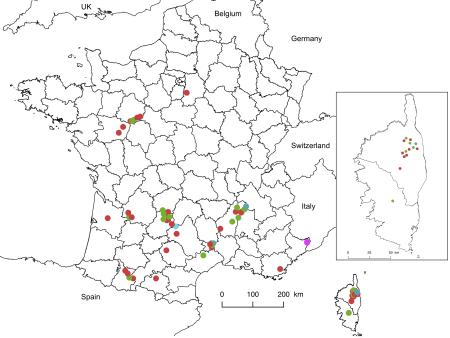
Objective:
The objective of the project was to implement in France a classical biological program against the chestnut gall wasp, Dryocosmus kuriphilus (Dk), using releases of the exotic parasitoid Torymus sinensis. The expected outcome of this project were (i) the permanent establishment of the parasitoid and (ii) an efficient and long-term control of the pest.
Context:
The chesnut gall wasp (Dk) was firstly reported in Japan in the 1940s where it led to a decrease of chestnut production up to 80%. With 1 million hectares located in France, C. sativa is very important for economic, environmental or landscape purposes. Dk was reported in 2010 in several areas of chestnut production in France. To optimize and coordinate actions to fight this invasion, a national committee was created to:
- group together all the stakeholders
- implement biological control using releases of the parasitoid Torymus sinensis (TS)
- document yield losses in order to gain financial supports for producers
Contacts:
Further information:
Borowiec N., Thaon M., Brancaccio L., Warot S., Risso S., Bertoncello E., Quacchia A., Ris N. and Malausa J.C. (2013). Lutte biologique contre le cynips du châtaignier. Phytoma 662, 32-35.
Al-Khatib F., Fusu L., Cruaud A., Gibson G., Borowiec N., Rasplus J.Y., Ris N., Delvare G. (2014). An integrative approach to species discrimination in the Eupelmus urozonus species complex (Hymenoptera, Eupelmidae) with the description of 11 new species from the Western Palaearctic. Systematic Entomology 39, 806-862.
Borowiec N., Thaon M., Brancaccio L., Warot S., Vercken E., Fauvergue X., Ris N. and Malausa J.C (2014). Classical biological control against the chestnut gall wasp Dryocosmus kuriphilus (Hymenoptera, Cynipidae) in France. Plant Protection Quarterly 29, 7-10.
Fleisch A., Thaon M. and Borowiec N. (2017). Parasitoïdes associés au cynips du châtaignier en Alsace. Phytoma 704, 8-10.
Fernandez-Conradi P., Borowiec N., Capdevielle X., Castagneyrol B., Maltoni A., Robin C., Selvi F., Van Halder I., Vétillard F. and Jactel H. (2017). Plant neighbour identity and invasive pathogen infection affect associational resistance to an invasive gall wasp. Biological Invasions. https://doi.org/10.1007/s10530-017-1637-4
Borowiec N., Thaon M., Brancaccio L., Cailleret B., Ris N. and Vercken E. (2018). Early population dynamics in classical biological control: establishment of the exotic parasitoid Torymus sinensis and control of its target pest, the chestnut gall wasp Dryocosmus kuriphilus, in France. Entomologia Experimentalis et Applicata 166, 367-179.
Viciriuc M., Thaon M., Moriya S., Warot S., Zhang J., Aebi A., Ris N., Fusu L. and Borowiec N. (submitted). Contribution of the integrative taxonomy to tracking past and recent interspecific hybridizations between the biological control agent Torymus sinensis and its related taxa. Biological Control.
Website of the biological control against D. kuriphilus in France (https://www6.inrae.fr/cynips-chataignier/)